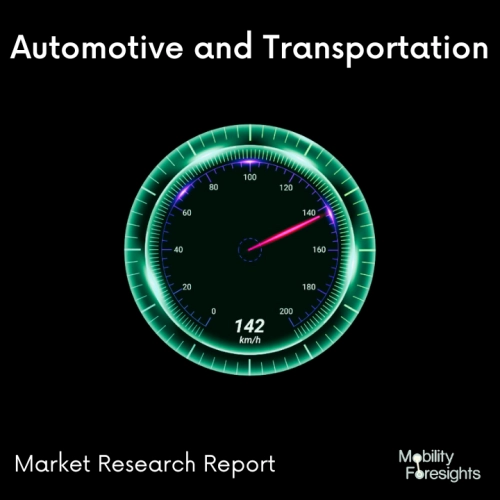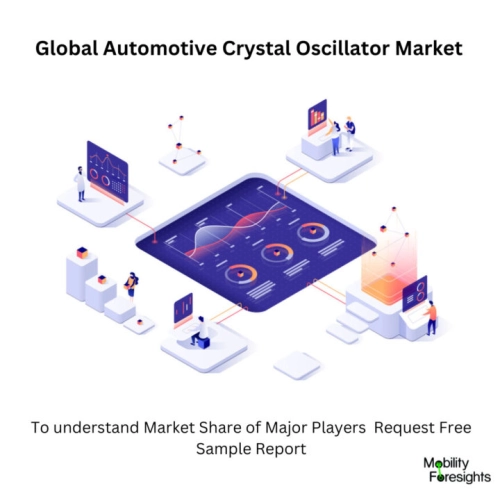
- Get in Touch with Us

Last Updated: Apr 25, 2025 | Study Period: 2023-2030
An electrical component called an automobile crystal oscillator is utilized in automotive applications to produce precise and reliable timing signals. It is a kind of electronic oscillator that produces a remarkably accurate and stable frequency by using a quartz crystal resonator.
Timing precision is essential for many processes and systems in automotive electronics, including engine control units (ECUs), fuel injection systems, ignition systems, advanced driver assistance systems (ADAS), infotainment systems, and communication modules.
These systems function with perfect timing, synchronization, and data transfer thanks to the automotive crystal oscillator.The following are some significant characteristics and factors pertaining to automobile crystal oscillators:
High-frequency stability is a feature of automotive crystal oscillators, which implies they keep a constant output frequency despite changes in temperature and ambient factors. For reliable and accurate timing in automotive applications, this stability is crucial.
Temperature Compensation: To reduce frequency variances brought on by temperature changes, automotive crystal oscillators frequently include temperature compensation systems. This guarantees that the oscillator will stay precise and stable even in the high temperatures present in automotive environments.
Automotive-grade AEC-Q200, which sets the qualification and reliability standards for electronic components used in automotive applications, is one industry standard that automotive crystal oscillators must adhere to. These oscillators are made to survive challenging automotive environments, such as EMI, mechanical vibration, and temperature extremes.

The Global Automotive Crystal Oscillator Market accounted for $XX Billion in 2022 and is anticipated to reach $XX Billion by 2030, registering a CAGR of XX% from 2023 to 2030.
Modern cars come with a wide range of modern features that make them simpler for drivers to operate. This comprises upgrades like Light Detection and Ranging (LiDAR), GPS, Engine Control, In-Vehicle Ethernet, Self-Driving Applications, and more.
By producing crystals and oscillators that are AEC-Q-approved, Suntsu is contributing to the advancement of these technologies.
Crystals and oscillators from Suntsu Electronics are AEC-Q200 and AEC-Q100 approved, enabling our customers to design the future of every industry, including the auto sector.
Due to Suntsu Electronics' IATF 16949-certified production facilities, we are able to meet the demanding requirements and extended temperature range certifications needed for automotive electrical components.
| Sl no | Topic |
| 1 | Market Segmentation |
| 2 | Scope of the report |
| 3 | Abbreviations |
| 4 | Research Methodology |
| 5 | Executive Summary |
| 6 | Introduction |
| 7 | Insights from Industry stakeholders |
| 8 | Cost breakdown of Product by sub-components and average profit margin |
| 9 | Disruptive innovation in the Industry |
| 10 | Technology trends in the Industry |
| 11 | Consumer trends in the industry |
| 12 | Recent Production Milestones |
| 13 | Component Manufacturing in US, EU and China |
| 14 | COVID-19 impact on overall market |
| 15 | COVID-19 impact on Production of components |
| 16 | COVID-19 impact on Point of sale |
| 17 | Market Segmentation, Dynamics and Forecast by Geography, 2023-2030 |
| 18 | Market Segmentation, Dynamics and Forecast by Product Type, 2023-2030 |
| 19 | Market Segmentation, Dynamics and Forecast by Application, 2023-2030 |
| 20 | Market Segmentation, Dynamics and Forecast by End use, 2023-2030 |
| 21 | Product installation rate by OEM, 2023 |
| 22 | Incline/Decline in Average B-2-B selling price in past 5 years |
| 23 | Competition from substitute products |
| 24 | Gross margin and average profitability of suppliers |
| 25 | New product development in past 12 months |
| 26 | M&A in past 12 months |
| 27 | Growth strategy of leading players |
| 28 | Market share of vendors, 2023 |
| 29 | Company Profiles |
| 30 | Unmet needs and opportunity for new suppliers |
| 31 | Conclusion |
| 32 | Appendix |